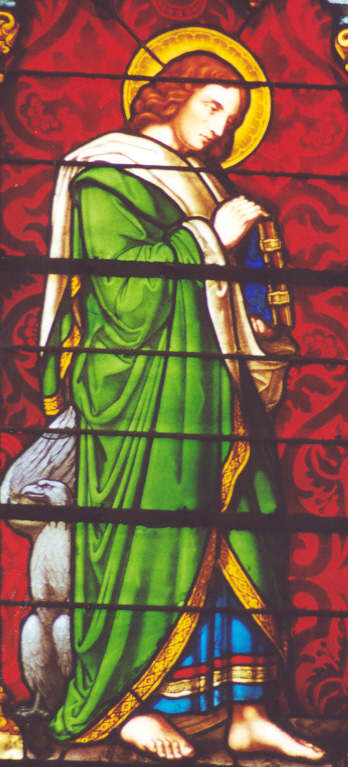
John 20:1-9
Four Gardens, each with Order, Beauty, Life
by Rev. Paul Scalia
Cycle B
Reprinted with permission of "The Arlington Catholic
Herald"
Home Page
To Sunday Gospel Reflections Index
John wrote to show that Christ was
the Messiah, the Divine Son of God.

On the first day of the week, Mary of Magdala came to the tomb early in the morning, while it was still dark, and saw the stone removed from the tomb. So she ran and went to Simon Peter and to the other disciple whom Jesus loved, and told them, "They have taken the Lord from the tomb, and we don't know where they put him." So Peter and the other disciple went out and came to the tomb. They both ran, but the other disciple ran faster than Peter and arrived at the tomb first; he bent down and saw the burial cloths there, but did not go in. When Simon Peter arrived after him, he went into the tomb and saw the burial cloths there, and the cloth that had covered his head, not with the burial cloths but rolled up in a separate place. Then the other disciple also went in, the one who had arrived at the tomb first, and he saw and believed. For they did not yet understand the Scripture that he had to rise from the dead.
“Mary of Magdala came to the tomb early in the morning.” (Jn 20:1) She comes to a garden. We know from the last words of the Passion read on Good Friday that the tomb of Our Lord was in a garden. (cf. Jn 19-41) This is not an unimportant detail, because salvation history can be understood as a story of gardens.
We find three essential elements in a garden: order, beauty and life. Order sets a garden apart from the wilderness. Its boundaries and design designate it as a specific place unlike any other. Second, a garden has beauty – diversity of flowers and plants, colors, sizes and shapes that pleases the eye. Finally, a garden has life. Plants grow and bear fruit, and animals find their territory a pleasing place to live.
This is what God desired for us in that first garden, the Garden of Eden: order, beauty and life. Order not just of the garden but of our own lives. He established us in a harmonious – well ordered – relationship with Him which bestowed in turn the integration of soul and body, man and woman, man and creation. Likewise the beauty of that first garden was not of the plants and flowers but of our souls, the surpassing beauty of the only creature created in His image and likeness. And He bestowed life there as well – the unending life with God.
By his sin Adam rejected the Gardener and lost the goods of the garden. We have lost order, beauty and life. Rebellion against God has thrown His creation into disarray. We now find soul pitted against body, man against woman, and all of creation at odds with man. It has brought the ugliness and horror of sin into the world. Most of all, it brought death into the world, death in place of life.
In a second garden Our Lord began the restoration, the redemption: “Jesus went… to where there was a garden, into which he and his disciples entered.” (Jn 18:1) He entered the Garden of Gethsemane to undo the rebellion of the Garden of Eden. In that garden He took upon Himself all the disorder, ugliness, and death that sin brought into the world. The entirety of it rushed upon and into Him. “He was in such agony and he prayed so fervently that his sweat became like drops of blood falling on the ground.” (Lk 22:44) He who is beauty itself became the man of sorrows. He who knew no sin became sin for us. (cf. 2 Cor 5:21) Life itself became death.
In the third garden Our Lord continues His work – by rising from the dead. How fitting that His tomb should be in a garden – to complete the restoration of God’s original plan. Indeed, when she first sees Him, Mary Magdalene takes Our Lord to be the gardener. (Jn 20:15) And in a certain sense, He is. He rises as the divine Gardener, to restore order, beauty and life.
He completes His work in a fourth garden: the human soul. He desires to reestablish within us His gifts of order, beauty and life intended from the beginning. Order, to heal that division and discord within us that produces all the division and discord outside of us. Beauty, to rid us of the ugliness of sin and grant us the glory of His children. And life, that our hearts become lively and life-giving.
On Easter, Mary Magdalene found Him in a garden. He rose in a garden so that we can in turn find Him within us, establishing His new garden of grace.